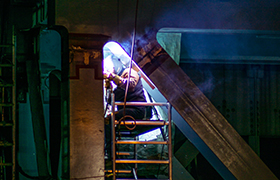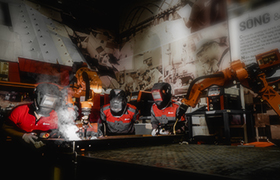The composition and operating principle of the hydraulic system for the molding line
Release Time: 2023-10-24
1、 Composition of the hydraulic system for the molding line
The transmission method that uses pressurized liquid as the working medium for energy transmission, conversion, and control is called hydraulic transmission. Compared with mechanical transmission, hydraulic transmission has various skill advantages such as high power, easy stepless speed regulation and overload maintenance, and flexible and convenient layout. As an important skill means for modern mechanical equipment to complete transmission and control, it is widely used in modern agriculture, manufacturing, power and coal industry, oil and gas exploration and chemical engineering, mining and metallurgical engineering, transportation engineering, building materials and construction industry, aerospace and river and sea engineering, scientific experimental equipment The fields of public facilities and national defense military engineering have been widely applied and have developed into indispensable components in the field of mechanical engineering. Hydraulic system refers to a whole composed of several specific fundamental circuits connected or combined to meet the operational requirements of a certain machine or equipment. Hydraulic system is generally composed of power components, performance components, control components, and auxiliary components. The functions and functions of each part are as follows:
1. Power components
The component that supplies power energy to the hydraulic system of the molding line, and the common power component in the hydraulic transmission system is the hydraulic pump. A hydraulic pump is an energy conversion component that supplies a liquid with a certain pressure and flow rate to the system, converting mechanical energy into liquid pressure energy. There are many types of hydraulic pumps, which can be divided into gear pumps, vane pumps, plunger pumps, and screw pumps according to their structural characteristics. They can be divided into two categories according to flow rate changes: quantitative pumps and variable displacement pumps.
The main parameters of hydraulic pumps include pressure, flow rate, speed, and power, which are mainly selected based on the operating conditions of the system. In order to ensure the normal operation of the system and the service life of the pump, generally in a fixed equipment system, the normal operating pressure is about 80% of the rated pressure of the pump; A system or moving equipment (such as vehicles) that requires high operational reliability, with a system operating pressure of about 60% of the rated pump pressure. The flow rate of the pump should be greater than the large flow rate of the system operation. In order to extend the lifespan of the pump, the high pressure and high speed of the pump should not be used together.
2. Fulfillment component
Performance components are the components that drive mechanical equipment to complete the required actions. The commonly used performance components in hydraulic transmission systems are hydraulic motors, including hydraulic cylinders that perform linear reciprocating motion and hydraulic motors that perform rotational motion. A hydraulic motor is also an energy conversion component that converts the input hydraulic energy into mechanical energy and outputs it to the dragged mechanical equipment.
Hydraulic cylinders are divided into thrust hydraulic cylinders and swing hydraulic cylinders. The main parameters include nominal pressure, inner diameter, piston rod diameter, and piston stroke. These parameters have been standardized into series and can be selected by designers
The main technical parameters of hydraulic motors include torque, speed, pressure, displacement, volumetric power, and total power. Hydraulic motors include gear motors, blade motors, plunger motors, and swing motors. Hydraulic motors should be selected based on the operating conditions. For low-speed operating conditions, in addition to using low-speed motors, high-speed motor acceleration and deceleration equipment can also be designed.
3. Control components
Control components refer to the components that control the force, speed, and direction of motion required to perform components in hydraulic transmission systems. The commonly used control components in hydraulic transmission systems are pressure control valves, flow control valves, and directional control valves. By controlling the oil pressure, flow rate, and direction of movement in the hydraulic system through hydraulic valves, the control of the output force, speed, and direction of movement of the performance components is completed.
4. Hydraulic working medium
Hydraulic working medium, as the name suggests, is a medium used to transmit hydraulic energy in hydraulic systems. The commonly used working media in hydraulic transmission systems include mineral oil hydraulic oil and flame resistant hydraulic fluid. This article mainly discusses the temperature rise control of hydraulic oil, and hydraulic oil will be specifically introduced in the next chapter.
5. Auxiliary component
Auxiliary components are used for the storage, filtration, transmission, sealing, heating, and cooling of hydraulic media, as well as for measuring and displaying hydraulic parameters. The auxiliary components in the hydraulic transmission system mainly include oil tanks, accumulators, oil filters, oil pipes and pipe joints, seals, heaters, coolers, pressure gauges, liquid level gauges, etc. These auxiliary components play an important role in ensuring the reliable, stable, and long-lasting operation of the hydraulic transmission system, and are an indispensable part of the hydraulic system.
2、 Main parameters and hydraulic circuit of the hydraulic system of the molding line
The main parameters of the hydraulic system of the molding line include pressure, flow rate, and power. According to the action cycle and cycle of each actuator, as well as the interlocking and requirements between the movements of each mechanism, the hydraulic system is composed of various simple hydraulic circuits assembled and assembled. The circuits that make up the hydraulic system include the main circuit (the part that directly controls the hydraulic actuator) and the auxiliary circuit (the part that adheres to the continuous and stable operation of the hydraulic system).
1. Main circuit
The main circuit includes the following four methods:
Power source circuit - generating hydraulic source, including hydraulic pumps (driven by electric motors for fixed machinery and internal combustion engines for walking machinery) and pressure operated valves. Generally, pumps operate continuously, so energy accumulators and unloading circuits are often added to achieve energy conservation and avoid heating. Mainly composed of pressure regulating circuit, unloading circuit, accumulator circuit, etc
Pressure control circuit - In order to ensure the overall hydraulic system, a relief valve with high response speed is used. In addition, in order to adapt to the forces required by different systems, commonly used pressure reducing valves, sequence valves, balance valves, pressure relays, etc., form some commonly used pressure circuits. Mainly composed of pressure regulating circuit, pressure reducing circuit, boosting circuit, unloading circuit, pressure maintaining circuit, pressure releasing circuit, balance circuit, buffer circuit, circuit, etc
Direction control circuit - using a directional valve to change the direction of movement of the actuator; The control methods include manual, mechanical, electromagnetic, hydraulic, electro-hydraulic, etc., which can be selected according to the intended use. It mainly consists of import, export, and bypass saving speed control circuits, variable displacement pump variable displacement motor (hydraulic cylinder) type, quantitative pump variable displacement motor type, variable displacement pump variable displacement motor type volumetric speed control circuit, etc.
Multi actuator circuit - sequence action uses sequence valves, stroke valves, pressure relays, and electrical stroke switches; Synchronous action uses energy-saving valves, diversion and collection valves, electro-hydraulic servo valves, and proportional valves. It can be selected based on the sequence of actions and synchronization accuracy. Independent actions do not affect or disturb each other, using electro-hydraulic servo valves, one-way valves, accumulators, etc. It mainly consists of pressure control sequence circuit, stroke control sequence circuit, time control sequence circuit, rigid connection synchronization circuit, saving synchronization circuit, diversion and collection synchronization circuit, mechanical feedback synchronization circuit, proportional oil discharge synchronization circuit, servo tracking synchronization circuit, anti disturbance circuit, etc.
2. Auxiliary circuit
The auxiliary circuit includes the following four methods:
Filter circuit - Install filters in front of important components in the suction pipe, return side pipeline, and pressure pipeline of the pump to maintain the hydraulic components from oil pollution.
Oil temperature control circuit - hydraulic equipment is equipped with a cooler (for forced cooling of severe heating systems) or a heater (to increase the oil temperature to the temperature for cold starting).
Oil tank and accessories - oil tank for holding oil, air filter for purifying air entering the tank, hydraulic gauge and thermometer for visually measuring liquid level and temperature.
Related Recommendations




